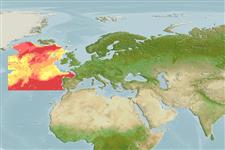>
Stomiiformes (Lightfishes and dragonfishes) >
Sternoptychidae (Marine hatchetfishes) > Maurolicinae
Etymology: Maurolicus: Greek,mauros, -os, -on = dark + Greek,lykos = wolf (Ref. 45335).
Environment: milieu / climate zone / depth range / distribution range
Ekologi
laut batipelagis. Deep-water
Northeast Atlantic: Azores.
Size / Weight / umur
Maturity: Lm ? range ? - ? cm
Life cycle and mating behavior
Maturities | Reproduksi, perkembang biakan | Spawnings | Egg(s) | Fecundities | Larva
Santos, R.S., F.M. Porteiro and J.P. Barreiros, 1997. Marine fishes of the Azores: annotated checklist and bibliography. Bulletin of the University of Azores. Supplement 1. 244 p. (Ref. 35204)
Status IUCN Red List (Ref. 130435)
ancaman kepada manusia
Harmless
penggunaan manusia
Alat, peralatan
laporan khas
muat turun XML
Sumber internet
Estimates based on models
Preferred temperature (Ref.
123201): 3.2 - 4.9, mean 3.7 °C (based on 356 cells).
Phylogenetic diversity index (Ref.
82804): PD
50 = 0.5000 [Uniqueness, from 0.5 = low to 2.0 = high].
Bayesian length-weight: a=0.00479 (0.00196 - 0.01170), b=3.16 (2.95 - 3.37), in cm total length, based on LWR estimates for this (Sub)family-body shape (Ref.
93245).
Trophic level (Ref.
69278): 3.2 ±0.2 se; based on size and trophs of closest relatives
Daya lenting (Ref.
120179): sedang, Waktu penggandaan populasi minimum 1.4 - 4.4 tahun (Assuming Fec < 1,000).
Fishing Vulnerability (Ref.
59153): Low vulnerability (10 of 100).
